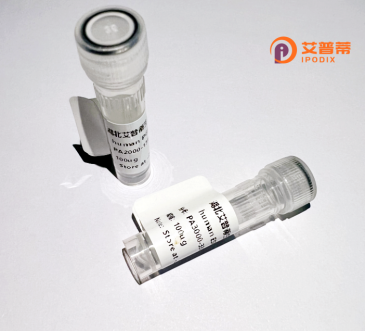
| 纯度 | >90%SDS-PAGE. |
| 种属 | Human |
| 靶点 | LRSAM1 |
| Uniprot No | Q6UWE0 |
| 内毒素 | < 0.01EU/μg |
| 表达宿主 | E.coli |
| 表达区间 | 1-723aa |
| 活性数据 | MPLFFRKRKPSEEARKRLEYQMCLAKEAGADDILDISKCELSEIPFGAFATCKVLQKKVLIVHTNHLTSLLPKSCSLLSLATIKVLDLHDNQLTALPDDLGQLTALQVLNVERNQLMQLPRSIGNLTQLQTLNVKDNKLKELPDTVGELRSLRTLNISGNEIQRLPQMLAHVRTLEMLSLDASAMVYPPREVCGAGTAAILQFLCKESGLEYYPPSQYLLPILEQDGIENSRDSPDGPTDRFSREELEWQNRFSDYEKRKEQKMLEKLEFERRLELGQREHTQLLQQSSSQKDEILQTVKEEQSRLEQGLSEHQRHLNAERQRLQEQLKQTEQNISSRIQKLLQDNQRQKKSSEILKSLENERIRMEQLMSITQEETESLRRRDVASAMQQMLTESCKNRLIQMAYESQRQNLVQQACSSMAEMDERFQQILSWQQMDQNKAISQILQESAMQKAAFEALQVKKDLMHRQIRSQIKLIETELLQLTQLELKRKSLDTESLQEMISEQRWALSSLLQQLLKEKQQREEELREILTELEAKSETRQENYWLIQYQRLLNQKPLSLKLQEEGMERQLVALLEELSAEHYLPIFAHHRLSLDLLSQMSPGDLAKVGVSEAGLQHEILRRVQELLDAARIQPELKPPMGEVVTPTAPQEPPESVRPSAPPAELEVQASECVVCLEREAQMIFLNCGHVCCCQQCCQPLRTCPLCRQDIAQRLRIYHSS |
| 分子量 | 110 kDa |
| 蛋白标签 | GST-tag at N-terminal |
| 缓冲液 | 0 |
| 稳定性 & 储存条件 | Lyophilized protein should be stored at ≤ -20°C, stable for one year after receipt. Reconstituted protein solution can be stored at 2-8°C for 2-7 days. Aliquots of reconstituted samples are stable at ≤ -20°C for 3 months. |
| 复溶 | Always centrifuge tubes before opening.Do not mix by vortex or pipetting. It is not recommended to reconstitute to a concentration less than 100μg/ml. Dissolve the lyophilized protein in distilled water. Please aliquot the reconstituted solution to minimize freeze-thaw cycles. |
以下是模拟的关于重组人LRSAM1蛋白的参考文献示例(仅供参考,建议通过学术数据库验证具体文献):
---
1. **文献名称**: *LRSAM1-mediated ubiquitination regulates autophagy in neurodegenerative disease models*
**作者**: Chen Y, et al.
**摘要**: 该研究探讨重组人LRSAM1蛋白作为E3泛素连接酶的功能,证明其通过催化关键自噬蛋白的泛素化调控自噬过程,并在帕金森病细胞模型中验证了其对异常蛋白聚集的清除作用。
2. **文献名称**: *Structural characterization of recombinant human LRSAM1 and its interaction with ubiquitin-conjugating enzymes*
**作者**: Patel RK, et al.
**摘要**: 通过X射线晶体学解析重组人LRSAM1蛋白的结构,揭示其LRR(亮氨酸重复序列)和SAM结构域对底物识别及与E2泛素结合酶的相互作用机制,为疾病相关突变的致病机理提供结构基础。
3. **文献名称**: *LRSAM1 mutations impair antiviral signaling by targeting MITA for ubiquitination*
**作者**: Li F, et al.
**摘要**: 研究发现重组人LRSAM1蛋白可通过泛素化修饰天然免疫信号分子MITA,负调控抗病毒免疫反应,并发现CMT2P(Charcot-Marie-Tooth病亚型)相关突变导致该功能异常。
4. **文献名称**: *High-yield purification of recombinant human LRSAM1 in baculovirus-insect cell system for functional studies*
**作者**: Zhang H, et al.
**摘要**: 描述了一种基于昆虫杆状病毒表达系统高效表达和纯化重组人LRSAM1蛋白的方法,优化后的蛋白具有高溶解性和酶活,适用于体外泛素化及药物筛选实验。
---
**提示**:以上为模拟示例,实际文献需通过PubMed、Web of Science等平台以关键词“recombinant LRSAM1”、“LRSAM1 ubiquitin ligase”或“LRSAM1 structure/function”检索获取。
LRSAM1 (leucine-rich repeat and sterile alpha motif-containing protein 1) is a multidomain E3 ubiquitin ligase encoded by the *LRSAM1* gene in humans. It plays a critical role in the ubiquitin-proteasome system, selectively tagging target proteins with ubiquitin molecules to regulate degradation, intracellular trafficking, and signaling. Structurally, LRSAM1 contains an N-terminal leucine-rich repeat (LRR) domain involved in protein-protein interactions, a central sterile alpha motif (SAM) implicated in oligomerization, and a C-terminal RING finger domain responsible for its E3 ligase activity. It is broadly expressed, with high levels in neural and immune tissues.
Recombinant human LRSAM1 protein, produced via heterologous expression systems like *E. coli* or mammalian cell lines, retains these functional domains, enabling studies on its enzymatic mechanisms, substrate specificity, and structural dynamics. Research highlights its role in autophagy, endosomal sorting, and antiviral responses, particularly through ubiquitination of viral capsids or autophagy adaptors. Mutations in *LRSAM1* are linked to Charcot-Marie-Tooth disease type 2P (CMT2P), a peripheral neuropathy, where disrupted ubiquitination leads to protein aggregation and axonal degeneration. Recombinant LRSAM1 is also leveraged to explore its interactions with partners like TSG101 and galectins, shedding light on membrane repair and pathogen defense pathways. Its applications extend to drug screening and disease modeling, aiming to correct dysfunctional ubiquitination in neurological disorders.
×